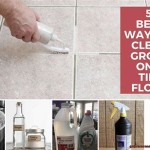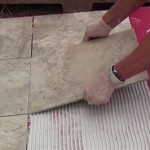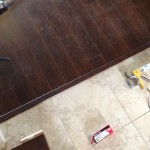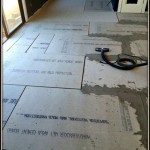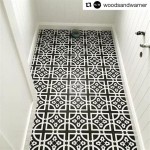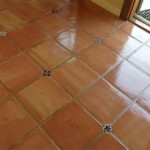Can You Put Linoleum On Top of Ceramic Tile? A Comprehensive Guide
The question of whether linoleum can be installed over existing ceramic tile is a frequently encountered query in both residential and commercial renovation projects. While technically feasible, the process requires careful consideration of several factors to ensure a successful and long-lasting result. Ignoring these key elements can lead to a variety of problems, including uneven flooring, adhesive failure, and even damage to the underlying tile.
This article will provide a comprehensive overview of the process, outlining the necessary preparations, potential challenges, and key considerations for determining if installing linoleum over ceramic tile is the right choice for a particular project. The focus is on providing unbiased, practical information to assist in making an informed decision.
Assessing the Suitability of the Existing Tile
The first and arguably most crucial step is a thorough assessment of the existing ceramic tile floor. The condition of the tile directly impacts the feasibility and longevity of the linoleum installation. Several factors must be examined:
Tile Stability: Each tile must be firmly adhered to the subfloor. Loose or cracked tiles will create an unstable base, precluding a smooth and even linoleum surface. Any loose tiles must be removed and replaced, and any cracks or chips must be repaired. Applying a self-leveling compound becomes essential in this case as well.
Surface Level: Variations in tile height, grout line depth, and uneven surfaces are common challenges. Linoleum is a relatively thin and flexible material, meaning any imperfections in the underlying surface will telegraph through to the finished floor. Deep grout lines are particularly problematic, as they can create depressions in the linoleum over time. A self-leveling underlayment is often necessary to create a perfectly smooth surface. This product is poured over the existing tile and dries to a hard, level finish. The thickness of the self-leveling compound will depend on the severity of the surface imperfections.
Tile Cleanliness: A meticulously clean surface is essential for proper adhesive bonding. The tile must be free from grease, dirt, wax, and any other contaminants. A thorough cleaning with a degreasing agent followed by a rinse with clean water is necessary. Allowing the tile to dry completely before proceeding is imperative.
Moisture Content: Excess moisture can compromise the adhesive bond between the linoleum and the tile. It's important to identify if moisture is a problem in the subfloor. The concrete slab under the ceramic floor tile needs to be tested for moisture to prevent any mold or bubbling up of the future laminate. Employing a moisture meter is recommended to assess the moisture content of the subfloor and the tile itself. If elevated moisture levels are detected, remediation measures, such as installing a moisture barrier, are required before installing the linoleum.
Grout Condition: The quality of grout plays an important role. Is it cracked, missing pieces, crumbling or brittle? If so, it will inevitably cause problems with the linoleum. Also, you want to analyze how much grout there is. If the tile is laid out so the joints are close together and thin, it isn't an issue. But if there is significant grout between the tiles, a self-leveling compound may be necessary.
Preparation and Installation Considerations
Once the existing tile has been assessed and deemed suitable, the preparation and installation process requires careful attention to detail. Proper preparation is vital for a successful and aesthetically pleasing outcome. The following considerations are essential:
Surface Preparation: As mentioned earlier, cleaning the tile surface is paramount. This includes removing any existing coatings, such as waxes or sealants. Once cleaned, the surface may need to be roughened slightly to improve adhesion. This can be achieved using a floor buffer with an abrasive pad. After roughening, the surface must be vacuumed thoroughly to remove any dust or debris.
Self-Leveling Underlayment: If the tile surface is uneven or has deep grout lines, a self-leveling underlayment is crucial. The underlayment should be applied according to the manufacturer's instructions, ensuring proper mixing and pouring techniques. Allow the underlayment to dry completely before proceeding with the linoleum installation. This may take several days, depending on the product and ambient conditions.
Adhesive Selection: Choosing the correct adhesive is critical for a secure and long-lasting bond. The adhesive must be compatible with both the linoleum and the ceramic tile. Consult the linoleum manufacturer's recommendations for the appropriate adhesive type. Water-based adhesives are generally preferred for linoleum installations, as they are low in VOCs and easy to clean up. Always follow the manufacturer's instructions for adhesive application, including spread rate and open time. Using the wrong adhesive can lead to the linoleum detaching from the tile over time.
Linoleum Installation: Linoleum is available in both sheet and tile formats. Sheet linoleum requires more skill to install, as it involves handling large pieces of material and achieving seamless welds. Linoleum tiles are easier to install, but they may require more precise cutting to fit around obstacles. When installing linoleum, it is important to ensure that the material is properly acclimated to the room temperature for at least 24 hours before installation. This will help prevent shrinkage or expansion after installation. Roll the material using a heavy roller to make sure it adheres to the adhesive.
Seam Treatment: For sheet linoleum, proper seam treatment is essential to prevent water penetration and maintain a seamless appearance. This typically involves using a heat-welding process to fuse the edges of the linoleum sheets together. Heat welding requires specialized equipment and training, so it is typically best left to professionals. For linoleum tiles, tightly butting the edges together is sufficient, but using a seam sealer is recommended to prevent water penetration.
Expansion and Contraction: Consider the natural expansion and contraction of the different materials with temperature and humidity fluctuations. Leaving a small expansion gap around the perimeter of the room is recommended. This gap can be covered with baseboards or trim.
Potential Problems and Mitigation Strategies
Despite careful planning and execution, certain problems can arise when installing linoleum over ceramic tile. Being aware of these potential issues and having mitigation strategies in place is crucial for a successful project.
Adhesive Failure: Adhesive failure can occur due to improper surface preparation, incorrect adhesive selection, or excessive moisture. To prevent adhesive failure, ensure that the tile surface is thoroughly cleaned and roughened, and use the adhesive recommended by the linoleum manufacturer. Addressing any moisture issues before installation is also critical.
Telegraphing: Telegraphing refers to the visible appearance of imperfections in the underlying tile surface through the linoleum. This is more likely to occur with thinner linoleum products or when the tile surface is uneven. To minimize telegraphing, use a thicker linoleum product or install a self-leveling underlayment to create a smooth surface.
Grout Line Indentations: Over time, the grout lines in the underlying tile can create indentations in the linoleum. This is more likely to occur with softer linoleum products or when the grout lines are deep. To prevent grout line indentations, use a self-leveling underlayment to fill in the grout lines and create a smooth surface.
Moisture Damage: Moisture can penetrate the linoleum through seams or edges, leading to mold growth or adhesive failure. To prevent moisture damage, ensure that all seams are properly sealed and that the perimeter of the room is properly caulked. Addressing any existing moisture issues before installation is crucial. It is important to ensure bathrooms and laundry rooms are adequately ventilated.
Height Considerations: Adding linoleum over ceramic tile increases the overall floor height. This can create issues with door clearances, transitions to adjacent flooring, and accessibility. Consider the height difference and make any necessary adjustments, such as trimming doors or installing transition strips.
Underlayment Cracking: Self-leveling underlayment, while effective, can crack if applied too thinly or if the underlying surface is unstable. Follow the manufacturer's instructions carefully regarding application thickness. Ensure all loose tiles are properly adhered to the subfloor before applying the underlayment. Adding a flexible additive to the self-leveling compound may also help reduce the risk of cracking.

Installing Luxury Vinyl Over Existing Tiles Choices Flooring

How To Tile Over Linoleum Floors Correctly

Transform Your Home Installing Vinyl Flooring Over Ceramic Tiles City Wall And Floor

Can You Lay Tile Over Linoleum Rubi Blog Usa

How To Install Vinyl Flooring Over Tiles Linoleum Thrift Diving

Should You Install Vinyl Floor Over Tile

Can You Tile Over Linoleum Networx

How To Lay Vinyl Flooring Sheet Over Tiles

Can I Lay Premium Vinyl Flooring Over A Tile Floor Hometalk

Can You Tile Over Linoleum Flooring Maria Louise Design
Related Posts

